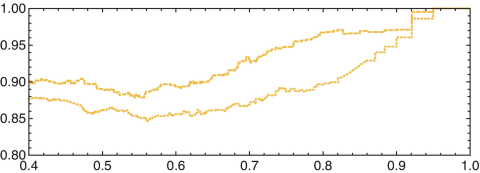Abstract
The simulation experiments presented in this chapter rely on highly simplified modeling assumptions. That is, there is nobackground knowledge, new arguments are constructed randomly, and proponents adopt the coherent position which is closest to their previous one. These simulations will serve to scrutinize a simple hypothesis, which says that the overall consensus reached in a debate at some step t depends on two factors: (1) the initial agreement between proponents and (2) the inferential density of the dialectical structure at step t. We will try to gauge, roughly, which combinations of inferential density and initial agreement typically generate a full consensus. A more detailed analysis of the simulation uncovers that the dynamic geometry of the space of coherent positions exerts a pivotal influence on consensus evolution in a debate.
Access this chapter
Tax calculation will be finalised at checkout
Purchases are for personal use only
Notes
- 1.
The software which is used to carry out the simulations of this study is documented at http://sourceforge.net/projects/ardys/
- 2.
The initial incline is due to the sampling of the initial proponent positions (cf. footnote 10): With this sampling method, roughly 2.5% of the proponent positions initially agree. This contrasts with an unadjusted random sampling where the proportion of identical positions is negligible. So, in the first few steps of the random debate evolution, the purelycoincidental agreements, which are due to the sampling method, are destroyed as proponents adjust, independently of each other, their positions to new arguments.
- 3.
This explanation suggests the following further test. If we partition all position pairs according to their agreement at a density of, say, 0.4 (rather than according to their initial agreement), the position pairs with high agreement should also possess a high likelihood of ending up on the same cluster, provided the debate is fragmented, and thence converge much faster than the corresponding position pairs on a compact debate. There are, in our ensemble, 78 position pairs in fragmented debates and 76 position pairs in compact debates which agree, at a density of 0.4, by more than 80% of the sentences. The evolution of the average normalized agreement of these two sets of position pairs is depicted in the following plot.

The dashed line represents the mean agreement evolution of the closely related position pairs in fragmented debates; the dotted line visualizes the corresponding evolution in compact debates. Both in fragmented and in compact debates, mean agreement drops as the density rises beyond 0.4 to densities between 0.5 and 0.6. In fragmented debates, this decline is turned, at a density of 0.6, into a rise which ends abruptly at a density of 0.8, having reached a mean agreement level well beyond 95%. In compact debates, in contrast, mean agreement slowly declines until a density of roughly 0.6 and, subsequently, starts a rather slow and gradual increase which catches up with mean agreement in fragmented debates—taking into account the initial difference at a density of 0.4—no earlier than at a density of 0.9. The observable, slightly more rapid mean agreement increase in fragmented debates can be attributed to the opinion island effect, which causes closely related position pairs, caught on one and the same isolated segment of the space of coherent positions, to approach each other as this segment is gradually contracted.
Author information
Authors and Affiliations
Rights and permissions
Copyright information
© 2013 Springer Science+Business Media Dordrecht
About this chapter
Cite this chapter
Betz, G. (2013). The Consensual Dynamics of Simple Random Debates. In: Debate Dynamics: How Controversy Improves Our Beliefs. Synthese Library, vol 357. Springer, Dordrecht. https://doi.org/10.1007/978-94-007-4599-5_4
Download citation
DOI: https://doi.org/10.1007/978-94-007-4599-5_4
Published:
Publisher Name: Springer, Dordrecht
Print ISBN: 978-94-007-4598-8
Online ISBN: 978-94-007-4599-5
eBook Packages: Humanities, Social Sciences and LawPhilosophy and Religion (R0)



